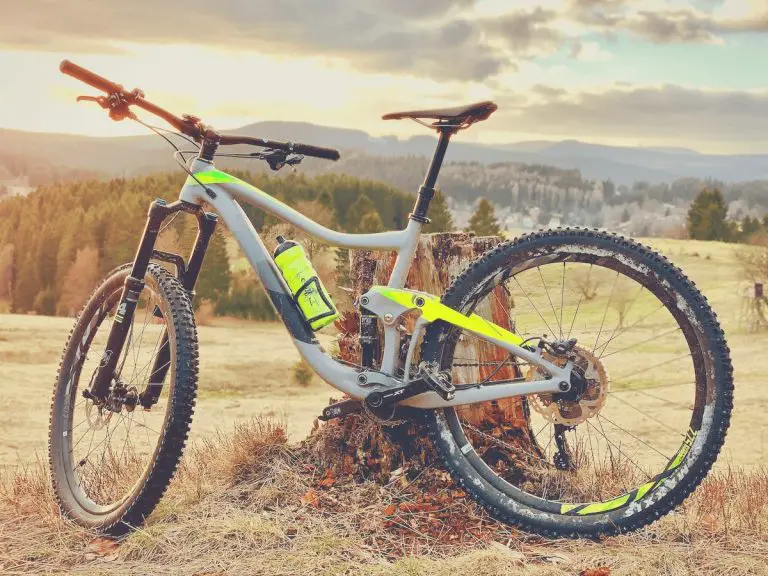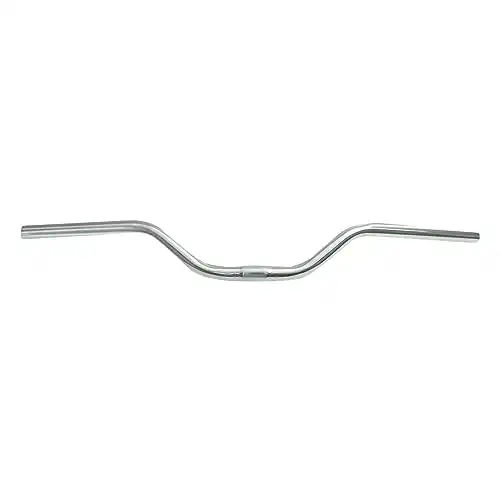Ever tackled a rugged trail and felt like your bike’s steering was just a tad off? Chances are, it’s the handlebars. But which ones truly enhance that mountain biking experience?
To give you that edge on the trails, I’ve descended steep slopes, navigated tricky terrains, and picked the brains of fellow MTB enthusiasts. The result? A shortlist of the best MTB handlebars out there. No more second-guessing your gear!
Eager for the top contender? Look no further than the Wake MTB Handlebar Riser. What makes it stand out among its peers? The answer might just thrill you!
Ready for the nitty-gritty on the best bars in the business? Dive into this guide and take control of your ride! 🚴♂️🌄🚴♀️
Summary of the Best Mountain Bike Handlebars
- Lightweight and durable aluminum alloy material
- Fits most mountain bikes
- Wide
- Affordable
- Good for aggressive cycling
- Strong and lightweight
- Wide and ergonomic
- Versatile
- Durable and corrosion-resistant
- Comfortable grip
- Durable
- Extremely lightweight
- Excellent control and stability on rough terrain
- A good budget option
- Good strength-to-weight ratio
- Easy to mount
Detailed Reviews of the Best MTB Handlebars on the Market
This handlebar riser is made of high-quality aluminum alloy and is designed to fit most mountain bikes. It has a diameter of 31.8mm and a length of 720mm, which makes it perfect for riders who want to improve their control and stability on the trails.
The surface has a water-resistant coating that’s also non-slip, ensuring you can use this handlebar in extreme weather without losing control of your MTB.
The back sweep is 9 degrees, which falls within the optimal defined range. In addition, the rise is a comfortable 30 millimeters, compatible with most sitting positions, even if you’re an aggressive rider.
The bar weighs just under a pound, while the width is a generous 780 millimeters. You have the option of four colors: red, blue, black, and yellow, to suit the style and personality of your bike.
One thing I don’t like about this product is the flex. Some riders reported an uncomfortable flex in the handlebars when they use them on extreme terrain, which is a consequence of the material used. Aluminum is less stiff than titanium, steel, or carbon fiber!
Another minor drawback is that it doesn’t come with instructions on how to install it. However, installation is pretty straightforward and can be done with basic tools.
The Wake MTB Handlebar Riser is most suitable for intermediate to advanced riders looking for an affordable, reliable, and durable handlebar riser to withstand the most demanding trails.
Funn has been in business for over two decades, and the Funn Full On MTB Handlebar is one of its most popular products.
Constructed from tough AL6061 alloy, the Full On is a solid combination of performance and value. It is a lightweight and robust handlebar with a durable, non-slip coating. With six color options, you’re spoiled for choice with different models available for this handlebar.
The design and production process makes this handlebar best suited for enduro bikes. It’s also suitable for downhill and freeride riders who need a reliable and responsive handlebar.
Enduro bikes require wider bars with sweeps optimized for aggressive riding, which the Funn handlebar delivers. It has an impressive width of up to 810 millimeters while maintaining a weight of around 0.75 pounds.
Back and upsweep are 5.5 and 8 degrees, respectively, which are great measurements for beginner to intermediate riders who want to try a more aggressive riding style.
One feature that would be handy to have on this handlebar is increased stiffness for more extreme terrains.
Other than that, there isn’t much else wrong with this model. In fact, it offers nearly identical performance to my top choice. The only difference is that the Wake MTB Handlebar Riser is slightly cheaper!
If you’re looking for a versatile handlebar that can handle both mountain and city biking, the Sunlite handlebars are a great choice. This isn’t the case with most handlebars on this list.
These handlebars are made of high-quality steel, which makes them durable and long-lasting. They also feature a comfortable grip that ensures a smooth ride, even on rough terrain.
The Sunlite Steel Handlebar is corrosion-resistant and has a width of nearly 700 millimeters. Because steel is relatively cheap and easy to construct metal, many riders report how easy it is to weld extra material to the handlebar to increase the width.
The 3.5-inch rise provides comfort for low-profile city bikes and is great for tall people and riders with posture problems.
However, these handlebars are not perfect for everyone. Some drawbacks that I noticed are:
- The handlebar weighs 1.25 pounds, which means it’s the heaviest handlebar on this list. It will add some extra weight to your bike and affect its speed and agility.
- They are not very adjustable in terms of height and angle. They might not fit your preferred riding posture and style.
Funn features once more on this list! This time with a carbon fiber handlebar.
The Black Ace Handlebar is made of high-quality carbon fiber that offers strength and stiffness without adding too much weight.
The handlebar comes in only one color but has three different versions, each with a different-sized rise. The rise ranges from 7 to 30 millimeters, with the heaviest of these versions weighing an impressive 0.454 pounds.
This is undoubtedly the lightest handlebar in this roundup, which is expected considering the material used.
This handlebar is ideal for riders who want to improve their performance and comfort on the trails. It can handle rough terrain and aggressive riding without compromising control and stability.
It also reduces hand fatigue and vibration, thanks to its ergonomic design and carbon material.
With all these features, it is no surprise that this is also the most expensive product on this list. But by investing in this handlebar, you get a really long product life cycle. Most riders have reported after five years of regular use, they only have a few scratches on it!
Most of the bars on this list have been riser bars. These are extremely popular, but some riders prefer the familiarity of a flat bar.
The UPANBIKE handlebar is ideal for riders who prefer a more upright riding position, as it reduces the strain on your back and neck. It also allows you to have a better view of the trail ahead, which can improve your safety and performance.
Additionally, the flat design provides a comfortable grip and reduces fatigue during long rides. This is only 620 millimeters wide but offers a great weight-to-strength ratio because of its aluminum construction.
Another great feature of this handlebar is the price. It’s an incredibly affordable handlebar. But note, it doesn’t come with any grips or bar ends, which means you’ll have to buy them separately.
One other drawback is the width of the handlebar. It might be too small for taller riders!
How To Choose A Mountain Bike Handlebar
Handlebars are an essential point of contact with your bike. Despite mountain bike handlebars being a personal choice for most people, there are a few things you should look out for before purchasing one.
I will discuss the four most important things to remember when looking for your next MTB handlebar.
Geometry
Your handlebar’s geometry consists of two main components: rise and sweep.
- Handlebar rise: This is the difference in height between the center of the handlebar and that of the tapered ends. The rise depends on the seating position of the cyclist. If your sitting position appears too low, a riser bar like the Funn Full On MTB Handlebar will help keep you comfortable.
- Handlebar sweep: The two measures of sweep are upsweep and downsweep. Upsweep measurements should range between 4 and 5 degrees to keep the wrist in a comfortable, neutral position. Downsweep measurements vary between 0 and 45 degrees, with most beginners preferring a downsweep between 5 and 9 degrees.
Handlebar Width
The wider, the better. That’s because a wide handlebar provides a much longer lever to steer a bike. This longer lever is easier to control than a much shorter one.
Wide bars also ensure you can practice good posture and be in a better position to breathe. If your chest is wide open because your hands are far apart, you’ll breathe much easier than if your arms are close together.
If you have short arms, wide bars may not be the best for you as they can cause discomfort.
Bar widths range from 600 to 860 millimeters. When buying handlebars, you’re better off purchasing a wide bar because you can cut it if it’s too wide. Unfortunately, you can’t always add material onto a narrow bar to make it wider!

Handlebar Material
Most purists argue between aluminum and carbon fiber.
Both are lightweight materials, but carbon is lighter and more expensive. Riders that prefer aluminum handlebars do so because these handlebars deform predictably – they bend or yield!
On the other hand, carbon fiber can snap without prior indication of deformation or if you have an accident.
In addition to the two materials mentioned earlier, you could also opt for solid steel or titanium, which most riders report is very good at absorbing shock. But this will likely come at the cost of a heavier bike.
When buying a handlebar, aluminum is often best for beginners. It’s lightweight and robust, without being too expensive. As you get more advanced in mountain biking, you can always change to a more premium handlebar.
Handlebar Shape
The conventional bar shape is a straight bar or riser bar.
But unusual shapes have populated the market. These shapes are meant to cater to different sectors of the mountain bike riding populations, like backpackers. Such handlebars will have an extreme rise in the center.
For beginners, try getting a more conventional handlebar: a straight or riser bar. You can always get a specialized handlebar as you progress in mountain biking.

Frequently Asked Questions
How does handlebar width affect my mountain biking experience?
A wider handlebar offers more control, especially in technical descents and aggressive trail riding.
However, it can be cumbersome in tight spaces. A narrower handlebar provides agility but might compromise stability. The key is to find the right balance for your riding style and terrain.
Why is vibration damping important in MTB handlebars?
Vibration damping reduces the shock transmitted to the rider’s hands and arms, especially in rough terrains. Effective vibration damping enhances comfort, reduces hand fatigue, and ensures better control over long descents and technical sections.
Is there a difference between handlebars for enduro vs. trail riding?
Yes. Enduro riding often requires aggressive descents and technical sections, so handlebars for enduro are typically wider for control and may have specific rise and sweep angles for optimal rider positioning.
Trail riding handlebars might be more versatile, balancing between control and agility.
Final Thoughts
My favorite is the Wake MTB Handlebar Riser. It’s an affordable product but offers excellent value and competes very well with the more premium models on this list.
It’s best suited to beginners who want to try out mountain biking without making substantial financial commitments.
Looking for a new MTB? Check out our comparison between a hardtail and full suspension mountain bikes.






